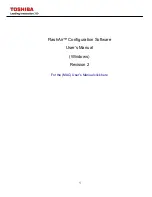
{ATINDEX audittrail-index-number }
{CPUS primary-CPU : backup-CPU
}
{PRIORITY priority
}
{PROCESS process-name }
{IMAGEVOLUME $volume }
{UPDATEVOLUME $volume
}
{INCLUDE subvol.file }
{EXCLUDE subvol.file }
{MAPFILE $vol.subvol.file }
{MAPLOG $vol.subvol.file }
ATINDEX
audittrail-index-number
is an integer value from 0 through 15 specifying the audit trail on the primary system to
which the data volume being protected is mapped. 0 specifies the MAT. 1 through 15 specifies
auxiliary audit trails AUX01 through AUX15, respectively. The default is 0.
CPUS
primary-CPU
:
backup-CPU
identifies the CPUs in which the updater process is to run as a process pair on the backup
system;
primary-CPU
is the primary CPU;
backup-CPU
is the backup CPU. Values range
from 0 through 15. The defaults are 0:1.
PRIORITY
priority
identifies the execution priority for the updater process;
priority
is the execution priority,
from 10 through 199. The default is 160.
PROCESS
process-name
identifies the process name for the updater process;
process-name
is any unique, valid
process name of up to six characters; the first character must be a dollar sign ($). You cannot
specify any of the reserved process names listed in the Guardian Procedure Calls Reference
Manual.
This parameter is not optional. You must explicitly name the updater process.
IMAGEVOLUME $
volume
identifies a disk volume associated with a secondary image trail previously added to the
RDF configuration (by way of an ADD IMAGETRAIL command), implicitly associating this
updater process with that trail.
This parameter is required. There is no default. An updater must always be explicitly
associated with a secondary image trail.
UPDATEVOLUME $
volume
specifies what volume on the backup system will receive database updates for the
corresponding volume on the primary system. You specify the corresponding volume on the
primary system in the ADD command that actually configures the updater process. The
default is $SYSTEM.
INCLUDE
subvol.file
specifies what subvolume(s) and file(s) on the primary system data volume are to be replicated
by the updater process on the backup system.
subvol
can have the wildcard character as a
suffix (DB*, for example, specifying all subvolumes whose names begin with DB). Similarly,
file
can be an explicit filename, the wildcard character (specifying all files on the designated
subvol
), or have the wildcard character as a suffix (DATA*, for example, specifying all files
on the designated
subvol
whose names begin with DATA).
EXCLUDE
subvol.file
specifies what subvolume(s) and file(s) on the primary system data volume are not to be
replicated on the backup system. As with the INCLUDE clause,
subvol
can have the wildcard
character as a suffix, and
filename
can be an explicit filename, the wildcard character, or
have the wildcard character as a suffix.
RDFCOM Commands
237
Содержание NonStop RDF
Страница 68: ...68 ...
Страница 186: ...186 ...
Страница 260: ...260 ...
Страница 278: ...278 ...
Страница 284: ...284 ...
Страница 290: ...290 ...
Страница 308: ...308 ...
Страница 322: ...322 ...
Страница 336: ...336 ...
Страница 348: ...348 ...
Страница 464: ...464 ...
Страница 478: ......
















































